
Fruit tree recommendations for South East QueenslandThe following recommendations are based on my experience growing fruit and nut trees in South East Queensland. A lot of these fruit have a poor shelf life so you are unlikely to find them in the shops, but taste better and are easier to grow than more familiar commercial crops. In considering pest resistance, keep in mind that I do not have possums, on account of our power lines being underground, but I do have rats, bats, fruit flies and a variety of grubs. I do not use any insecticides other than soapy water on the fig tree. I use a lot of mulch and a bit of fertiliser.
Jaboticaba (Plinia cauliflora)
|
| Taste | ★★★★★ |
| Easy to grow | ★★☆☆☆ |
| Pest resistance | ★★★★★ |
Native habitat: tropical South America, second story (ie shaded) but can be grown in full sun.
Bears fruit in September, October and November.
Jaboticaba are my favourite. They are slow growing and delicate when young, but well worth the effort. I recommend directly planting seeds in a small patch of worked soil, surrounded by thick mulch. They are a tropical fruit and do better with a lot of water, especially when fruiting. No pests touch them, but I have heard of birds eating them further inland. Apparently you can get multiple crops per year, but so far I only get one, although the last one went for nearly 2 months. To eat the fruit, pierce the skin with your canine and suck out the inside, then spit out the seed(s). The skins are edible but taste a bit ‘tanniny,’ and if you have one tree you will have more than enough fruit and will end up discarding them. The fruit can be dried, frozen or turned into jam or wine, though I have not tried any of these options - I don’t get quite enough fruit yet. The trees have small, pale green leaves with copper coloured new growth and are naturally hedging, so make a nice ornamental tree and are suitable for small gardens. They remain small in the sub tropics. The leaves of my seedlings turned yellow, which I initially thought was some kind of nutrient deficiency, but is apparently just a reaction to full sun and not particularly harmful. I have also just planted some large leaf Jaboticaba (Myrciaria jaboticaba), which taste almost as good and apparently grow faster. They produce larger fruit, with a slight roughness to the skin. I am also growing some yellow jaboticaba, which is fast growing, but the fruit I have tasted had very little pulp. I also recently picked up a white jaboticaba seedling, but don't know much about them.
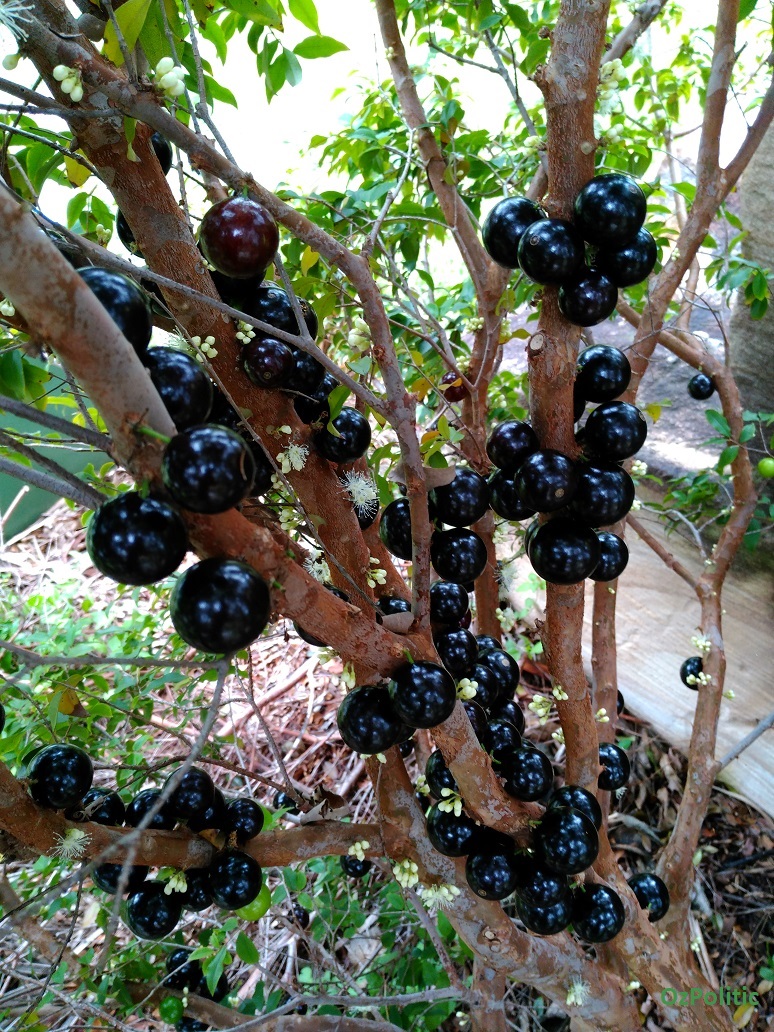
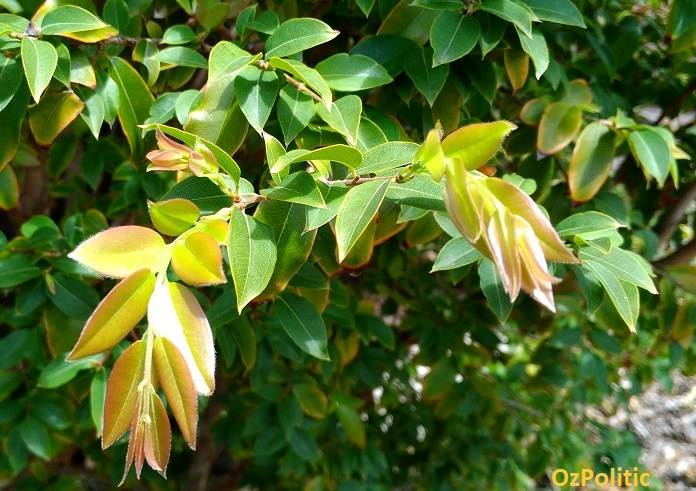
Peanut Butter Fruit (Bunchosia glandulifera)
top
| Taste | ★★★★☆ |
| Easy to grow | ★★★★★ |
| Pest resistance | ★★★★★ |
Native habitat: central and south America.
Bears fruit in late summer?
These fruit have an unusual taste and texture, like peanut butter, but sweet. They ripen sequentially, so have a long fruiting season. The tree will continue flowering after you have started picking the first fruit. After heavy rain, ripe fruit will get beads of a sweet honey-like liquid on the surface. The fruit are ripe when they change in colour from orange to dark red. This is a rapid transition, and the fruit softens. I let mine ripen on the tree, as the birds don't eat them (yet). The tree is small, multi-stemmed and bushy, with medium-sized leaves. It grows rapidly and will set fruit within a year or two. The seeds are large compared to the fruit size. I recommend planting seeds directly into the ground.
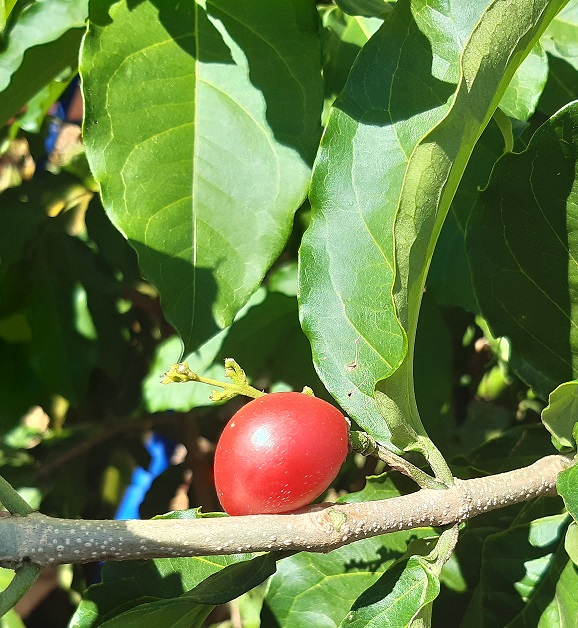
Grumichama (Eugenia brasiliensis)
top
| Taste | ★★★★☆ |
| Easy to grow | ★★☆☆☆ |
| Pest resistance | ★★★★☆ |
Native habitat: tropical South America
Bears fruit in December.
Like the Jaboticaba, this is another slow growing native to South America. The seedlings are particularly delicate and do not handle being transplanted well. I grew mine from seed. It is ideal for small gardens. It grows so slowly it is considered an endangered species. In spring it is completely covered in beautiful white flowers, on a background of dark green, glossy leaves. The fruit is sweet, but can be a bit woody if it over-flowers in response to heavy rain and then there is a dry spell. The fruit is pest resistant if you get in quick. If you leave the fruit to rot on the tree, the fruit flies will start to attack it. You can eat the skin on this one, after tearing off the leaflets on the base of the fruit. This one also grows dense and would make a nice hedge, although it is very slow growing.
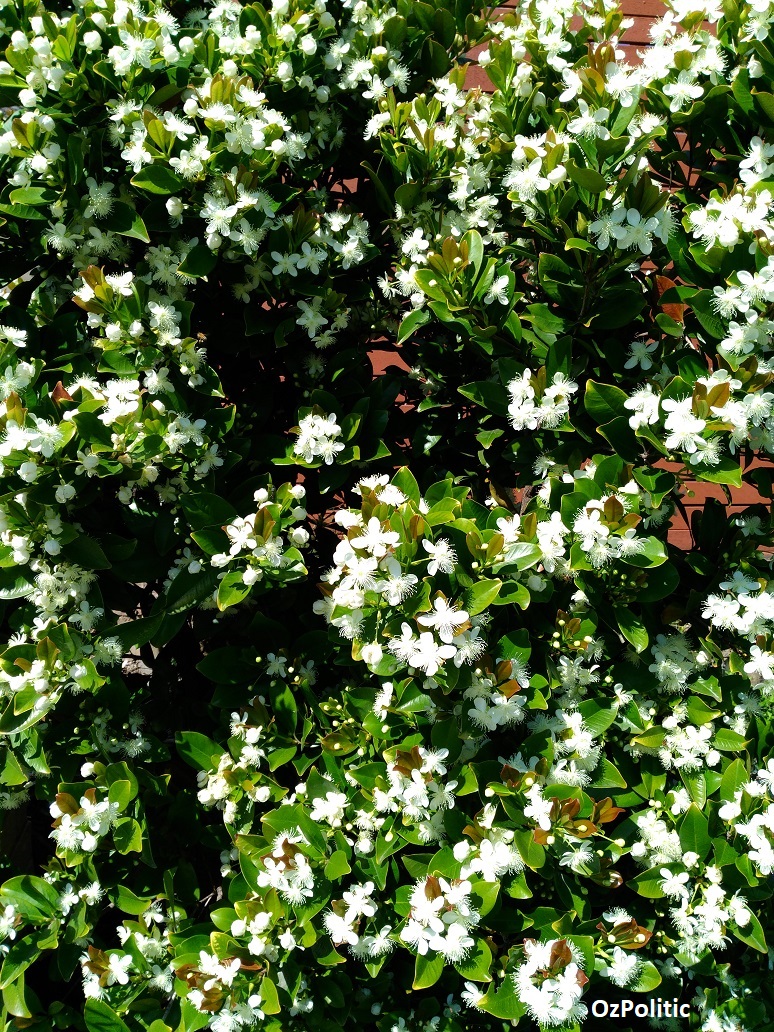
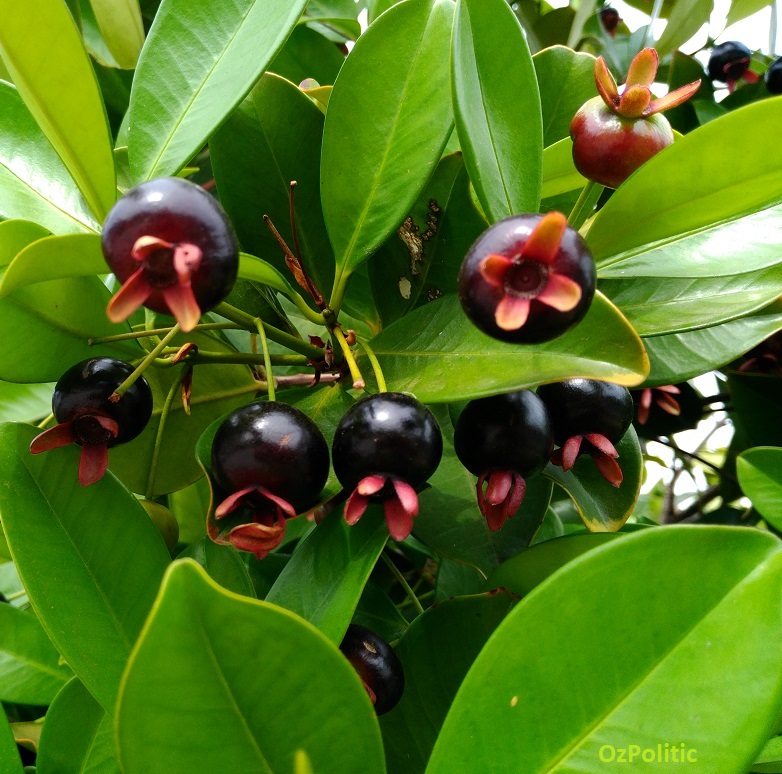
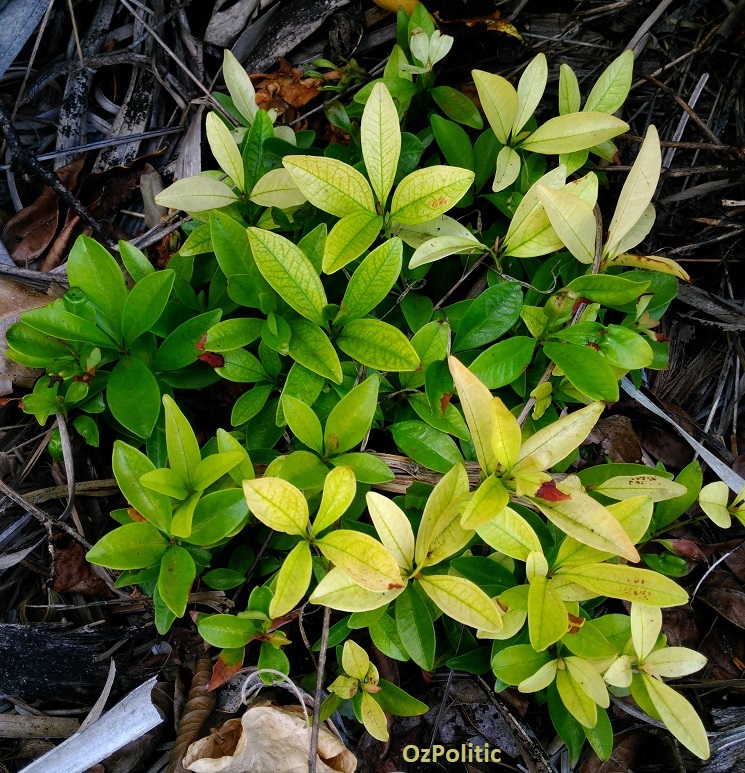
Surinam Cherry (aka Brazil Cherry, Eugenia uniflora)
top
| Taste | ★★☆☆☆ |
| Easy to grow | ★★★★★ |
| Pest resistance | ★☆☆☆☆ |
Native habitat: tropical South America
Bears fruit intermittently.
This easy-to-grow variety is a good starter plant if you want quick results. It is considered an invasive species in some places, and will self propagate. It can be pruned into a nice hedge. The fruit has a strong sour taste, though the larger, darker fruit tend to be a bit sweeter. The taste does grow on you, so don’t judge it entirely on first impressions. It gets nailed by fruit fly and some other pest that clings to the skin, but this does not stop me eating them. Try one, and if you enjoy having it in your garden, don’t plant any more - instead, try some of the more difficult to grow brazil cherries listed above. This one can be pruned into a nice hedge. I recently a acquired a black brazil cherry seedling. The fruit from these is supposedly sweeter.
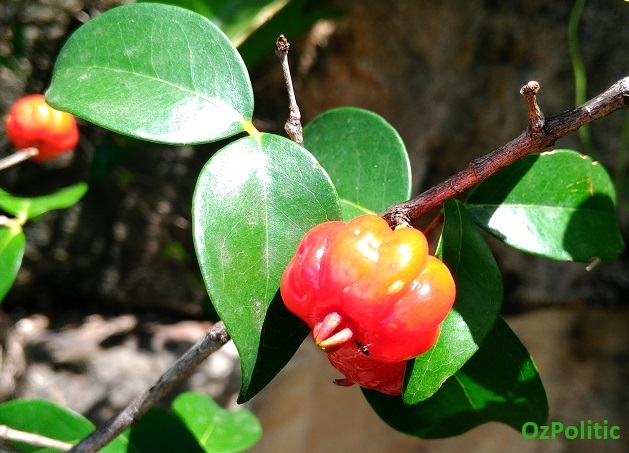
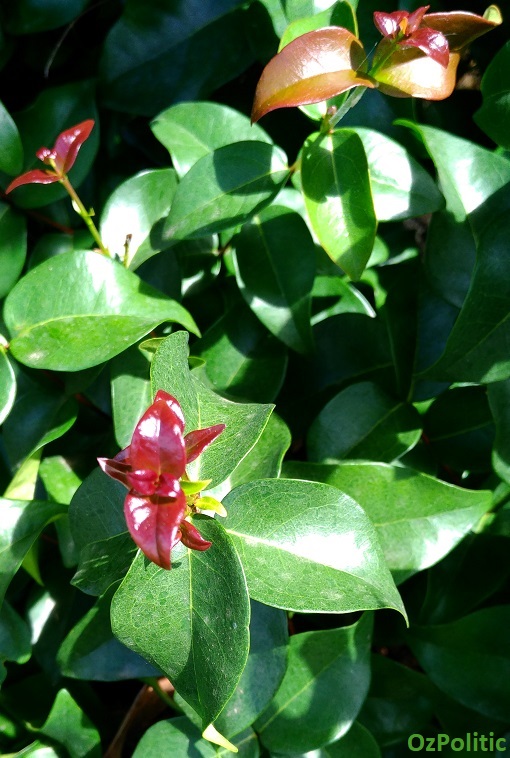
Black Sapote (Diospyros nigra)
top
| Taste | ★★★★★ |
| Easy to grow | ★★★★★ |
| Pest resistance | ★★★★★ |
Native habitat: central America
Bears fruit intermittently?
This is my second favourite. It’s other name is chocolate pudding fruit. When ripe, I put them in the fridge and have one for desert. You can mix them with ice cream, or make ice cream out of them. A small tree will produce multiple crops throughout the year. It is a relative of the persimmon, which explains why it is not a commercial success. You have to wait until the skin softens and turns dark to eat them, at which time the fruit is delicate. Eating them is messy - use a paring knife and a thin bladed tea spoon. They are not touched by pests, and I let mine ripen on the tree, though most people pick them earlier and ripen them inside. It grows well from seed. There are a lot of varieties. I am not sure what type mine is, but it is only a fraction of the size of my neighbour’s and produces a lot of fruit relative to the tree size. These trees come in male or female, so plant a few.
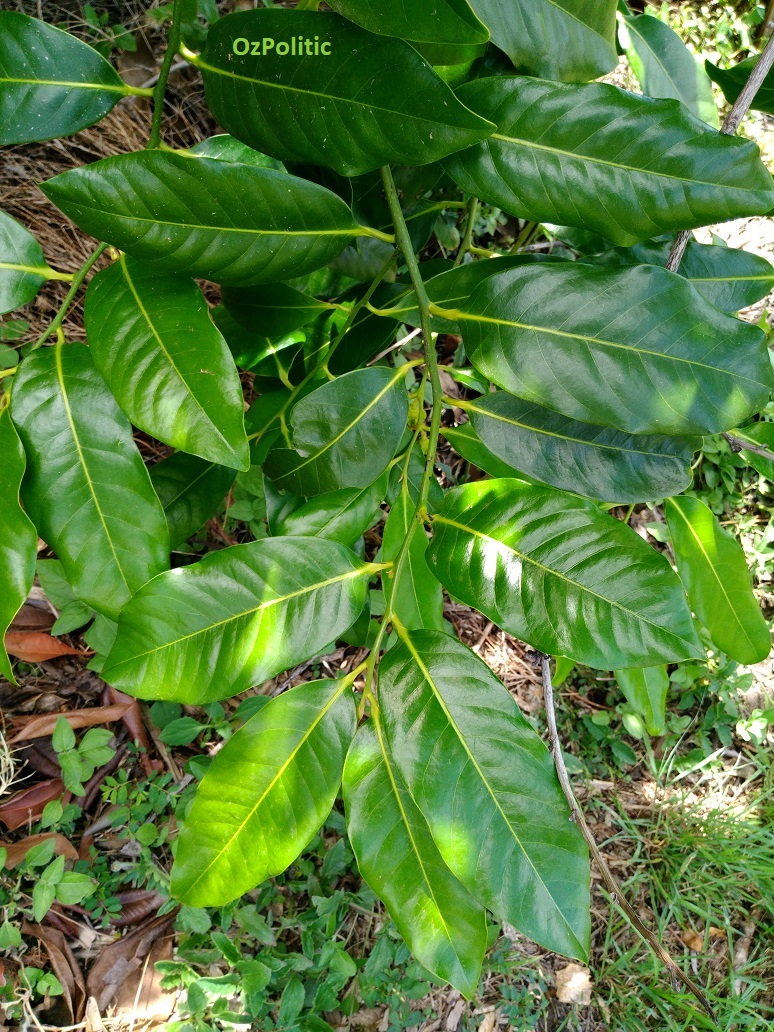
Dragonfruit (Hylocereus costaricensis)
top
| Taste | ★★★★★ |
| Easy to grow | ★★★★★ |
| Pest resistance | ★★★★★ |
Native habitat: central America
Bears fruit intermittently, after heavy rain.
This is my third favourite fruit. There are a few varieties of these. I think I have the Hylocereus costaricensis. This has red fruit with deep red flesh, and minimal spines on the ‘leaves’. I don’t think the variety with white flesh is as sweet. The taste is like a dense watermelon, not complex but very sweet, best served chilled. They are very easy to grow - just cut off a section and stick it in the ground. Like passionfruit, they take a while to get going, but keep growing exponentially. They look terrible, like a cross between a cactus and a vine, but I have seen them presented nicely growing inside a hedge. People typically grow them along a fence, but negotiate with your neighbour as they get very heavy. People sometimes freak out and think they have bowel cancer the next day when they drop the kids off at the pool, but this is just the red stain in the water. Dragonfruit grow wild in many locations and can grow to enourmous sizes, even engulfing medium size gum trees. This may be a good source of hardy stock, but they may not be the best tasting.
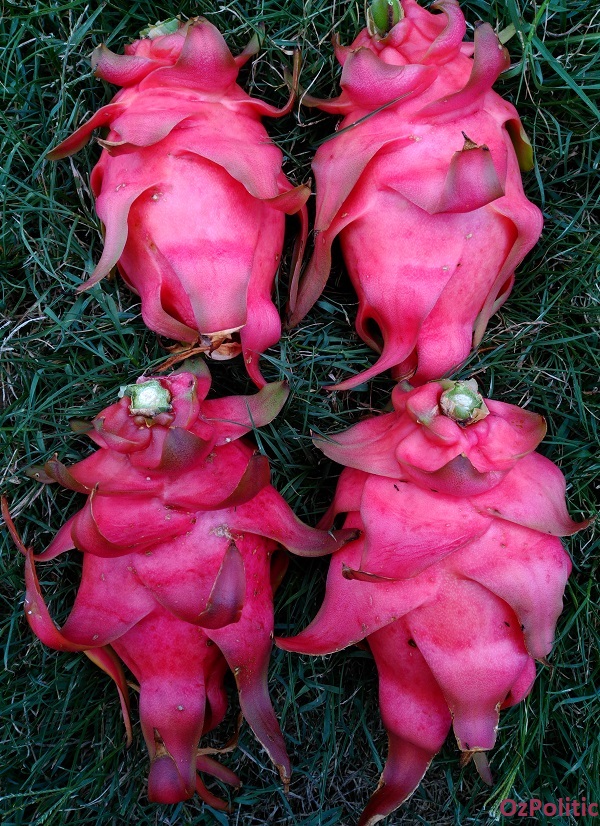
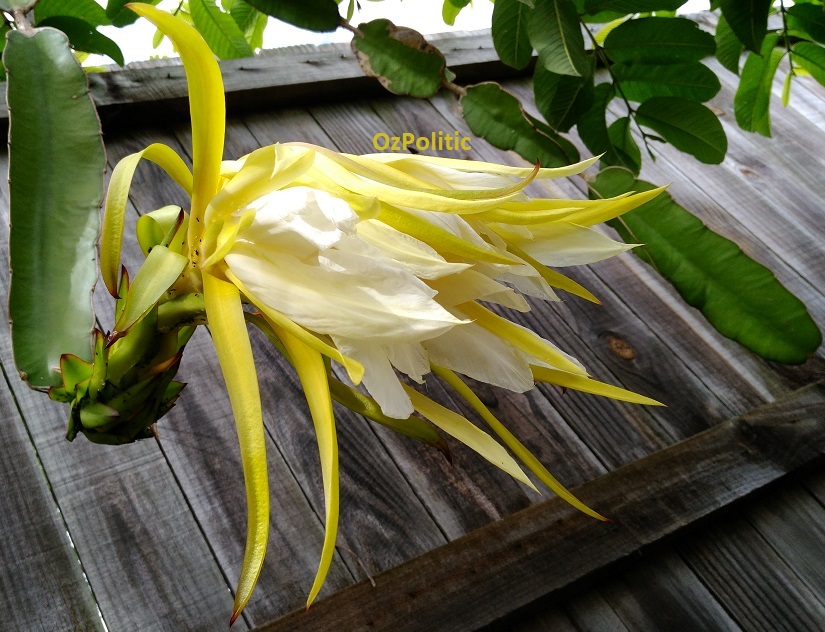
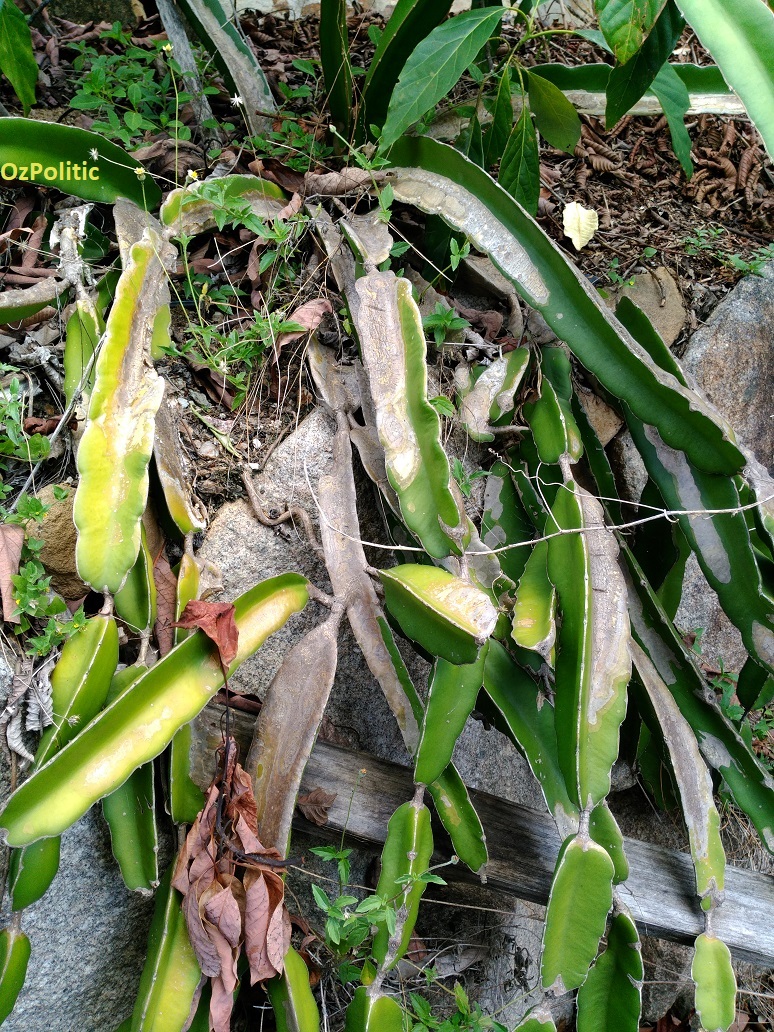
Mango - Bowen / Kensington Pride (Mangifera indica)
top
| Taste | ★★★★☆ |
| Easy to grow | ★★★★★ |
| Pest resistance | ★★☆☆☆ |
Bears fruit in January.
Native habitat: tropical Asia
I really just put this one here for comparison, as you should know what they are. Bowen mangoes can be grown from seed, but I bought mine as a seedling. The bats will get into them, but I have gotten crops of smaller trees despite some loss to bats. This year I have netted my tree. The trees will grow very large and provide good shade, but this makes it difficult to harvest the fruit.
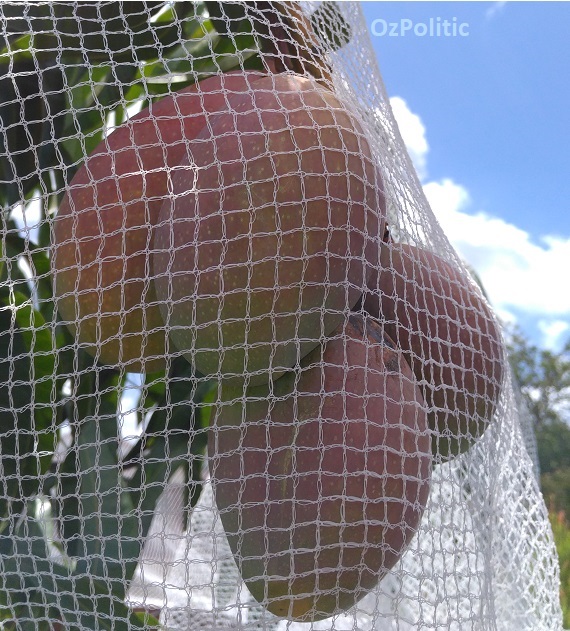
Fig - Black Genoa (Ficus carica)
top
| Taste | ★★★★★ |
| Easy to grow | ★★★★★ |
| Pest resistance | ★☆☆☆☆ |
Native habitat: Mediterranean
Bears fruit in February.
Another one I bought as a seedling. I prune mine heavily to shape the tree. They are a medium sized tree with soft wood, with a tendency to grow wide rather than high. I lose some fruit to bats, possums or rats, and grubs. I have some nasty little black maggot-shaped grubs that eat the leaves and stain your fingers if you touch them. I fight them by spraying the eggs and grubs with soapy water. Recently I have had more success by tearing part of the leaf if it has eggs on it. The eggs are small, orange and layed in a clump. I just drop the leaf section on the ground beside the tree, which is enough to kill them. I also have some large predatory bugs with a pointy nose that suck the insides out of the grubs, but they are slow to respond to the spring boom. If I miss the eggs and the grubs start eating leaves, I will tear off the whole leaf and discard, or hit it with soapy water. I also get beetles eating the leaves. I flick these off, which doesn’t work very well, but they are not such a problem.
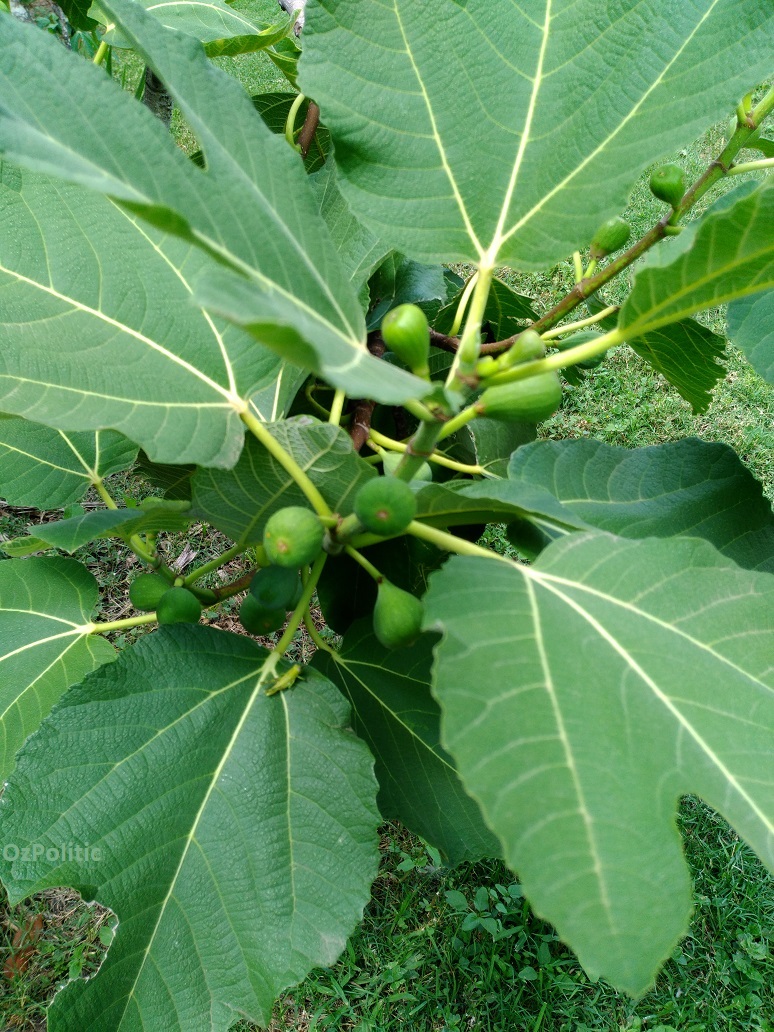
Banana (diploid cultivar of Musa acuminata)
top
| Taste | ★★★☆☆ |
| Easy to grow | ★★★★☆ |
| Pest resistance | ★★★★★ |
Native habitat: tropical Africa
Bears fruit intermittently. Each 'tree' lives a bit more than a year.
I am not entirely sure about the variety of this one. It is an old variety that has been in the family for a few generations. We call it ladyfinger, but it tastes different to the ones in the shop, and also handles differently - though both of these observations may be attributable to the ladyfinger bananas in the shop being picked before they are ripe. The fruit is short and stubby and has very thin skin that looks like it has been attacked by something, but the fruit inside is fine. The fruit has a strong sweet flavour that seems unusual if you are used to eating bananas from the shop. They are thirsty, but apart from that easy to grow, so select a location that is naturally wet. I divert my roofing downpipe onto them. They do sometimes blow over while fruiting, so if I suspect that is going to happen I will support it with rope. The tree will grow quickly and set fruit within a year, but the fruit take a long time to form and ripen, and will wait till warmer weather if they set in winter. Cut the purple flower off the fruit stem when it stops setting fruit. Apparently this saves ‘energy’ which is diverted to the fruit instead. Harvest the banana by cutting down the entire tree when you see a few yellowing fruit. You cannot leave the fruit to ripen on the tree, or the bats will get them. When you harvest a bunch of bananas, cut the hands off the bunch immediately. When the fruit is ripe, it will fall off the hand if disturbed, leaving the skin broken. I put the ripest fruit in the hottest room of the house and the greenest fruit in the coolest, to spread out the crop a bit. Putting them in a paper bag with a ripe banana will supposedly hasten ripening, as a ripe fruit releases chemicals that causes the other fruit to ripen quicker.
The ‘tree’ will self propagate rapidly, but this slows down fruiting. So, kill most of the saplings by cutting with a small, serrated paring knife, scooping out the middle, and dropping a teaspoon of kerosene in. Limit a clump to 3 trees at any one time. This will allow you to control which direction your clump grows in. Propagate by digging up a sapling and moving it. You may not get much root material on it, in which case it will need regular water until established (and then even more water…). Note that digging around the base of a tree may destabilise it and will reduce its growth. I wait until I have harvested a tree that grew in a dead-end direction and is a bit separated from the main clump, then I can safely get about 20 saplings from it before it dies off completely. I also have some Dwarf Cavendish growing, but am yet to get fruit from them. I recently harvested my first bunch of dwarf ducasse. These grow faster and crop more heavily, but the fruit is not as sweet. I had a Dwarf Red Dacca sapling, but a bug ate the core out of it and killed it, and I also lost a goldfinger sapling. Click here for more information.
You can eat the stem from a banana plant. It is a bit like water chestnut. Remove all the outer layers until you get down to a central core without the layering, then slice thinly and eat. It spoils on exposure to air very rapidly, however if you submerse it in water it can be kept for a day. It can be eaten fresh, in a salad, or in a stir fry. The first time I ate it, I fried it up with some banana fruit and chillis.
In the photos below, note the following: The stem/trunk of the tree has broken due to the weight of the bunch (and fallen over the top of another banana plant, which makes it a bit hard to see). This happened before the bananas were full size, but they continued to ripen normally. I picked the ripe hand from the top of the bunch, and the rest of the bunch ripened nearly overnight. The second photo was taken one day after the first. So there is not much point picking one hand at a time. For some reason the bats did not get into this bunch, despite leaving it on the tree late. The third photo shows scartches on a hand from near the top of the bunch. I am not sure what does this, but it does not seem to affect the fruit. Note also the top left banana has partly fallen off the hand. At this stage I have to handle each hand very delicately or the individual fruit snap off, leaving the skin broken and the fruit exposed. You need to separate the hands from the bunch well before this stage. Finally, the fruit has a thin skin, and tends to have a larger diameter on the outside end, perhaps due to crowding near the centre of the bunch. The thin skin may also be caused by letting the fruit ripen on the tree (due to osmosis, apparently).
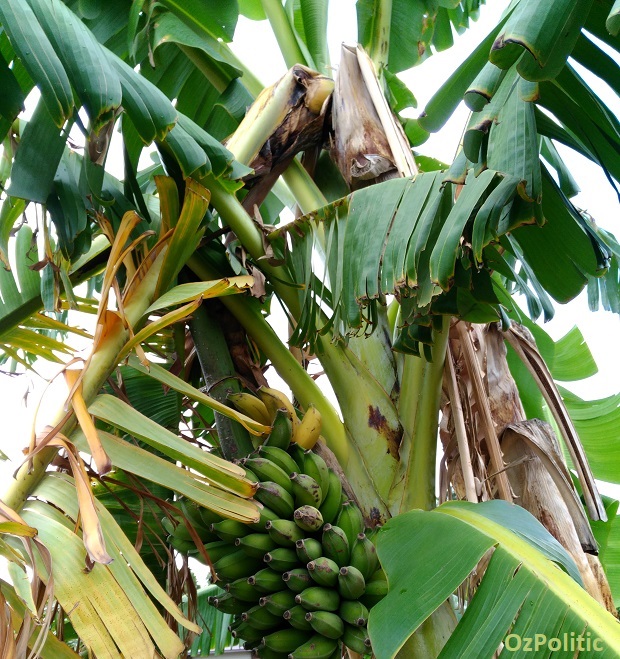
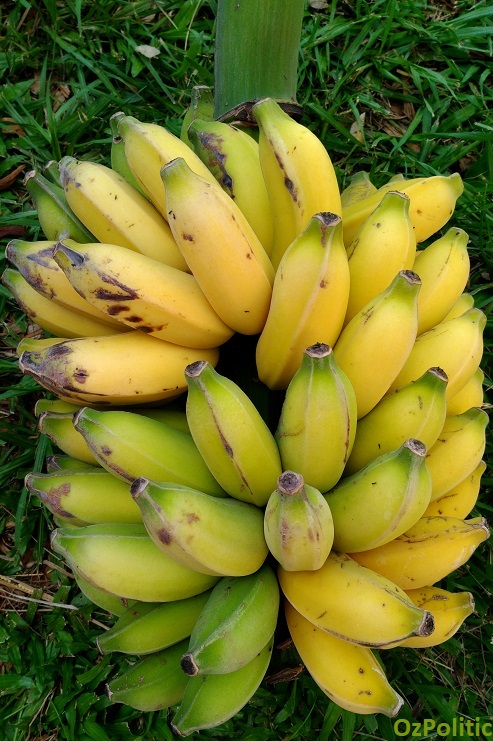
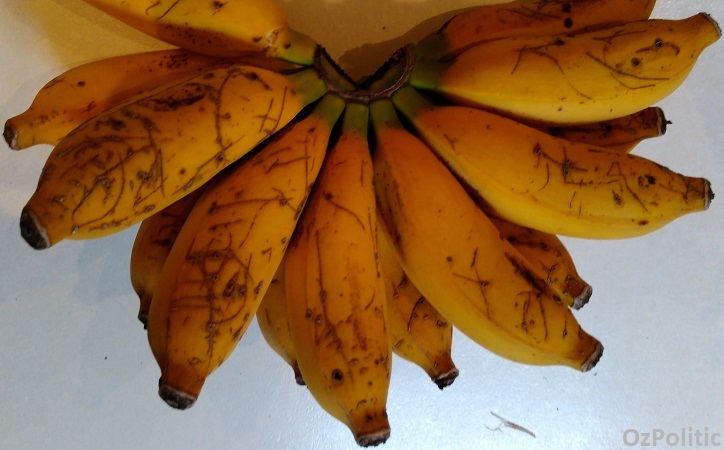
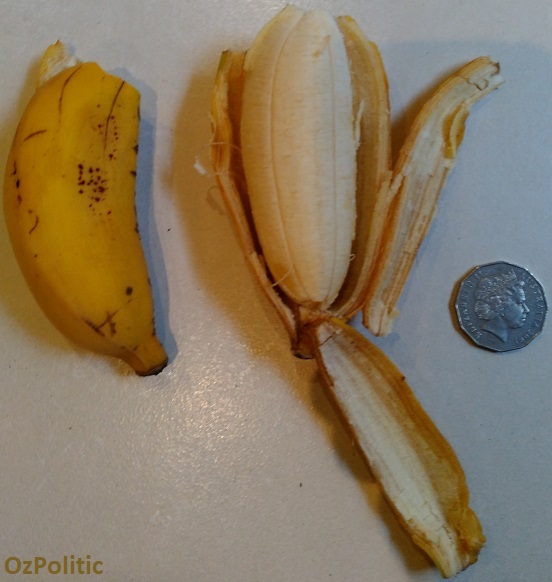
Pawpaw (Carica papaya)
top
| Taste | ★★★☆☆ |
| Easy to grow | ★★★★★ |
| Pest resistance | ★★★☆☆ |
Native habitat: tropical America
Bears fruit intermittently.
Everyone calls these pawpaws, but they are actually papayas. They are a very fast growing plant and can quickly produce a large crop, but do not live long. Younger plants seem to produce better fruit. Fruit bats are probably your main enemy, as well as rats or possums. Fruit fly stings them, but the fruit is still edible. I recently had sulphur crested cockatoos (I think) bite off every 'branch' on my best producing tree, which wiped out a large crop of fruit. They also get a black fungus in winter. Ideally get the seed from a good neighbourhood tree, otherwise seeds from a shop-bought fruit are fine. Click here for more information.

Macadamia (Macadamia integrifolia)
top
| Taste | ★★★☆☆ |
| Easy to grow | ★★★★★ |
| Pest resistance | ★★★★☆ |
Native habitat: South East Queensland
Bears nuts in February.
I bought mine from the shop. Apparently they do not produce nuts if you grow them from seed. I use large tree loppers to crack the nuts without making too much mess. These trees are great for kids, who will happily spend an afternoon with a hammer or brick harvesting them. The rats will collect all the nuts if you let them. They will grow fairly large, but are not a great shade tree as the leaves are unpleasant to walk on, and are spikey on some varieties. Click here for more information.
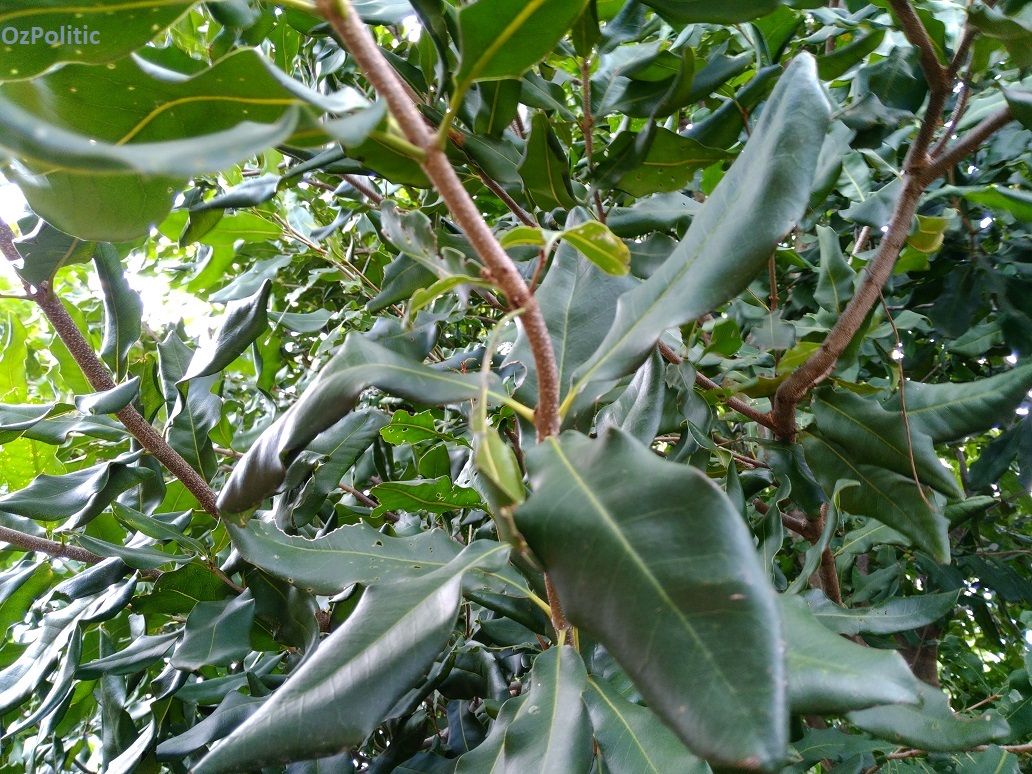
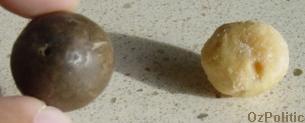
Passionfruit (Passiflora edulis, var flavicarpa)
top
| Taste | ★★★☆☆ |
| Easy to grow | ★★★☆☆ |
| Pest resistance | ★★★☆☆ |
Native habitat: southern Brazil
Bears fruit intermittently.
Passionfruit take a while to get established, but produce copious fruit when they do. There are a lot of varieties around. I grow yellow and purple ones, both of which I found growing wild. Older vines should be pruned heavily or they will stop producing fruit. I lose a lot to rats, but apart from that they are fairly pest resistant, on account of their thick skin (particularly the yellow ones). It can be difficult to get the seeds to germinate. I sometimes soak them in water and use find sandpaper to get the pulp off, which works well.
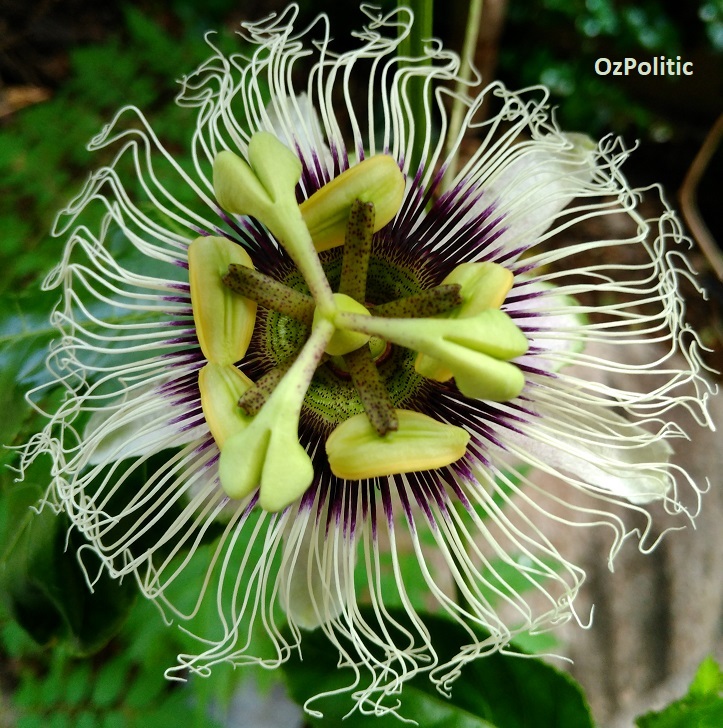
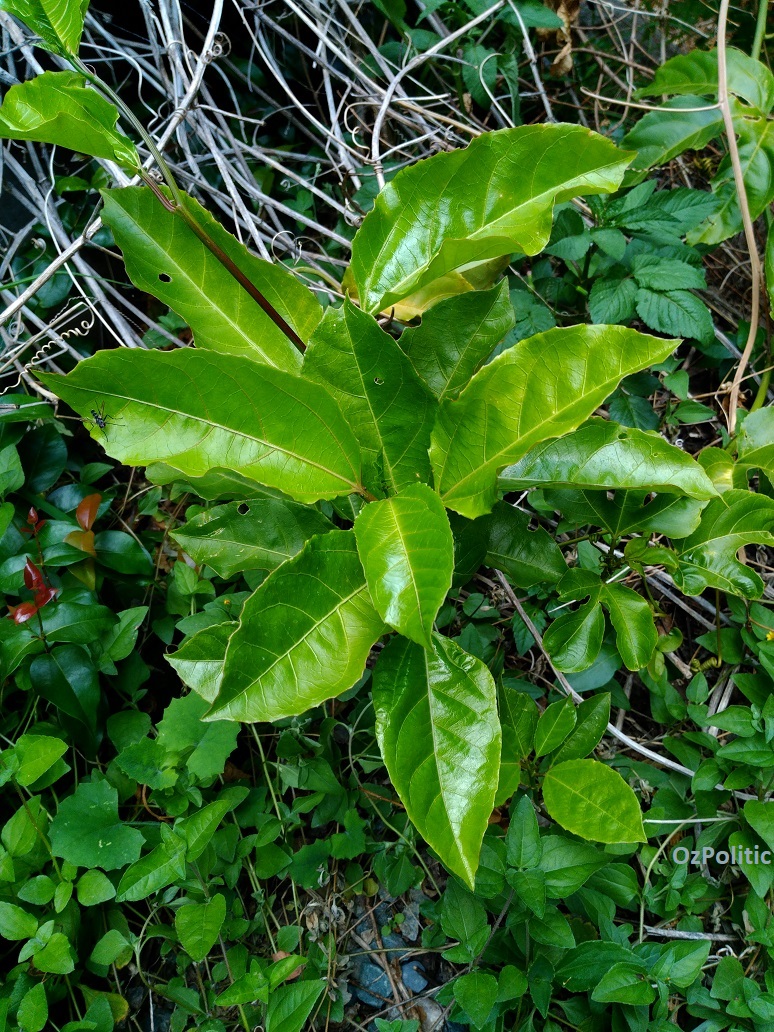
Mulberry (Morus ???)
top
| Taste | ★★☆☆☆ |
| Easy to grow | ★★★★★ |
| Pest resistance | ★★★☆☆ |
Bears fruit throughout summer.
Native habitat: temperate East Asia and North America
I bought this one, but I also see them growing wild nearby. I lose a lot of the crop to birds, probably because I let the fruit ripen completely on the tree. I prune the tree heavily to stop it toppling over under its own weight, and so I can walk under the branches, which tend to droop. I can still bend each branch down to harvest the fruit without a ladder.
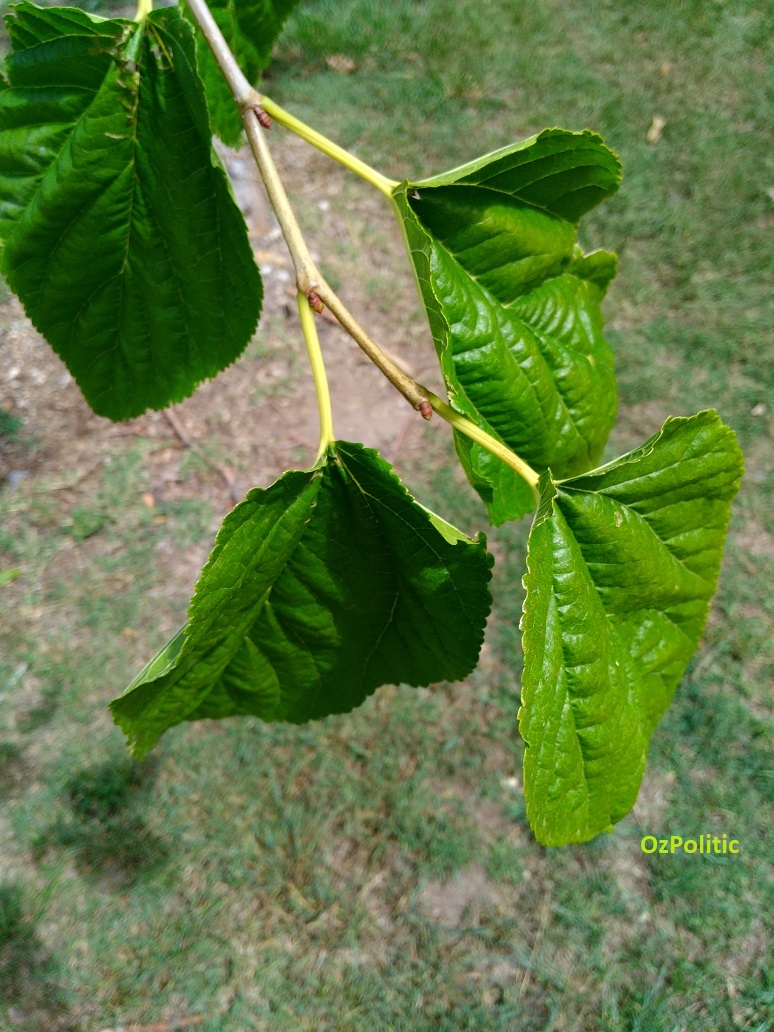
Guava (Psidium guajava)
top
| Taste | ★☆☆☆☆ |
| Easy to grow | ★★★★★ |
| Pest resistance | ★★☆☆☆ |
Native habitat: tropical southern Mexico
Bears fruit intermittently.
I found some yellow guava on a retaining wall beside the road and planted them. The skin on the fruit is thin and fruit flies get into them, as well as the rats. The taste is pleasant, but a bit bland. The seeds are as irritating to bite down on, but you can eat around them. It has a distinctive scent that becomes a bit overbearing if it gets too ripe. Best eaten crunchy, when they first turn yellow - skin and all, if there are not to many critters on the surface. They are a small, but very hardy tree. I think they would grow on a pile of rocks. I prune them into interesting shapes, as they are sturdy, have nice looking bark, and grow into interesting twisted shapes, like a miniature snow gum. They provide shade in awkward locations, and a frame for dragonfruit and passionfruit to grow on. I regularly strip them almost bare of leaves, as I don’t like to have the fruit rotting on the ground. I now have a few sprouting up nearby.
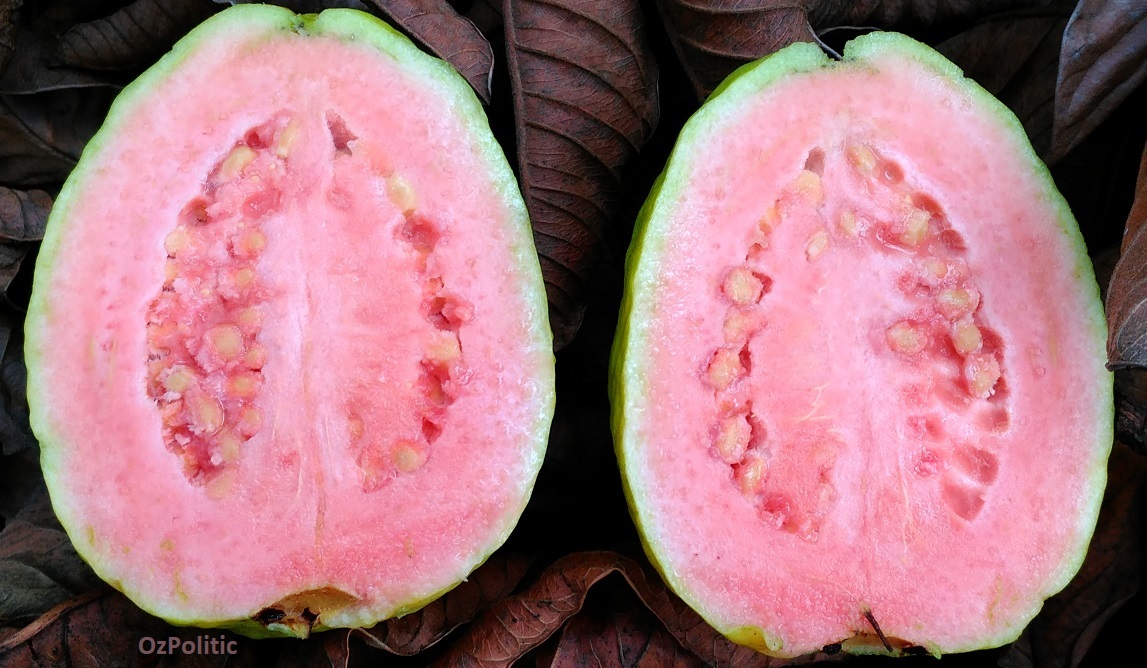
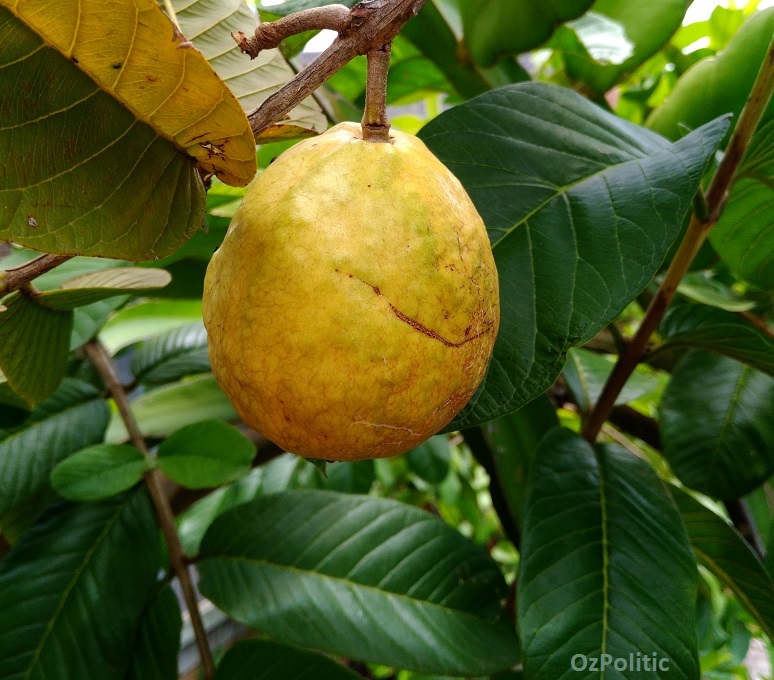
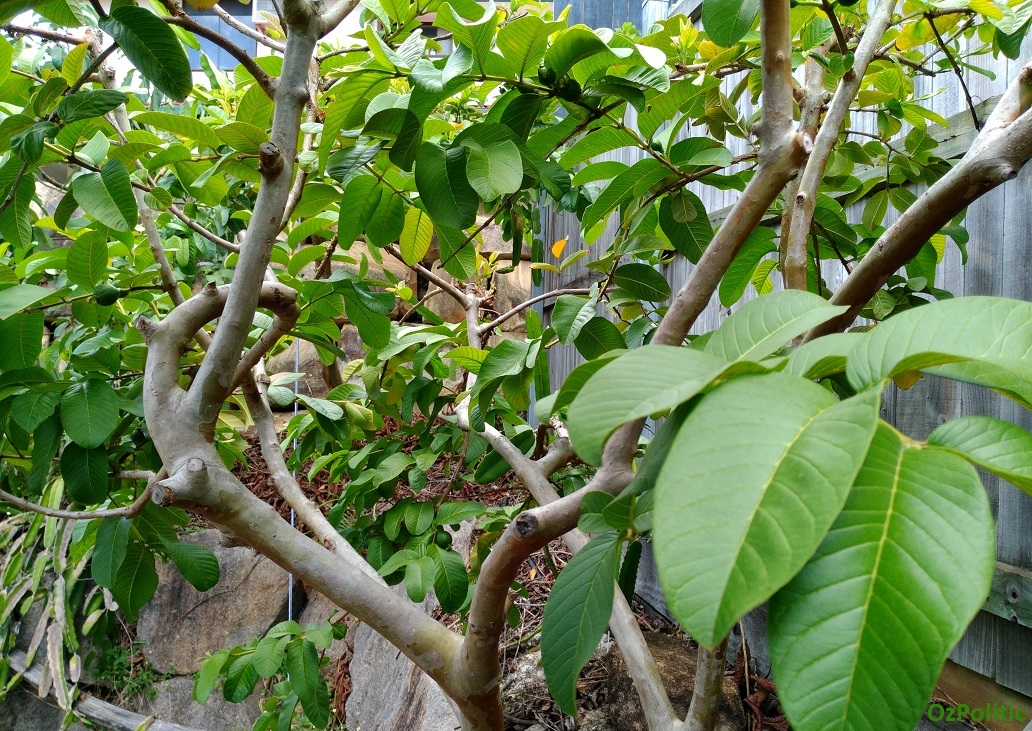
Bunya (Araucaria bidwillii)
top
| Taste | ★☆☆☆☆ |
| Easy to grow | ★★★☆☆ |
| Pest resistance | ★★★★☆ |
Native habitat: Queensland
Cones drop in January.
These are very large trees that resemble pines. They drop heavy cones that are larger than a football, weighing up to 10kg. The cones contain numerous edible seeds. The taste is similar to a potato, but without the flavour and texture. They are nice roasted and are a cheap substitute for pine nuts in pesto. I also mix them with honey to make a spread. Opening the seeds can be difficult. If you are camping, throw them in the fire and if they are fresh they will explode when cooked. This can also be done on a barbecue grill, but this gets a bit messy. They can be boiled, after which the shell can be peeled back with needle nose pliers. The easiest option is probably to chop them with a sharp machete and pick up the pieces. They can also be cut lengthways with a symmetric tree lopper. The cones have sharp spikes, similar to a pine cone but larger. Some people wear gloves when handling them. The leaves are also spikey and can draw blood on thin skin. Shoes should be worn when walking near the tree. This tree is ideal for your neighbour's yard, or public spaces that people rarely access (ie, no paths underneath, no mowed lawn). They are a nice looking tree with a distinctive domed crown with dark foliage, and are often planted in botanical gardens. Councils have also started planting them on inaccessible land in places like freeway intersections. They attract sulphur crested cockatoos, which will extract some of the nuts from the cone while it is still on the tree. Occasionally they will remove every nut before the cone falls. The seeds take a long time to germinate - several months under good conditions, and up to several years. The seed forms an underground tuber that lies dormant until the seedling emerges. Once the seedling emerges it is hardy, however they do not handle transplanting well, perhaps because of the tuber/root system, so the seeds are best planted in situ. I expect that larger, deeper pots would work well and have had some preliminary succes with them. Click here for more information.
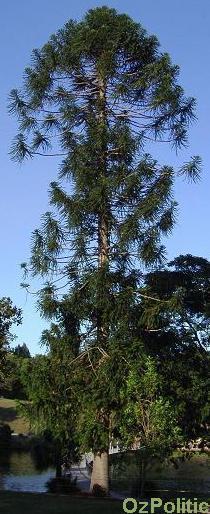
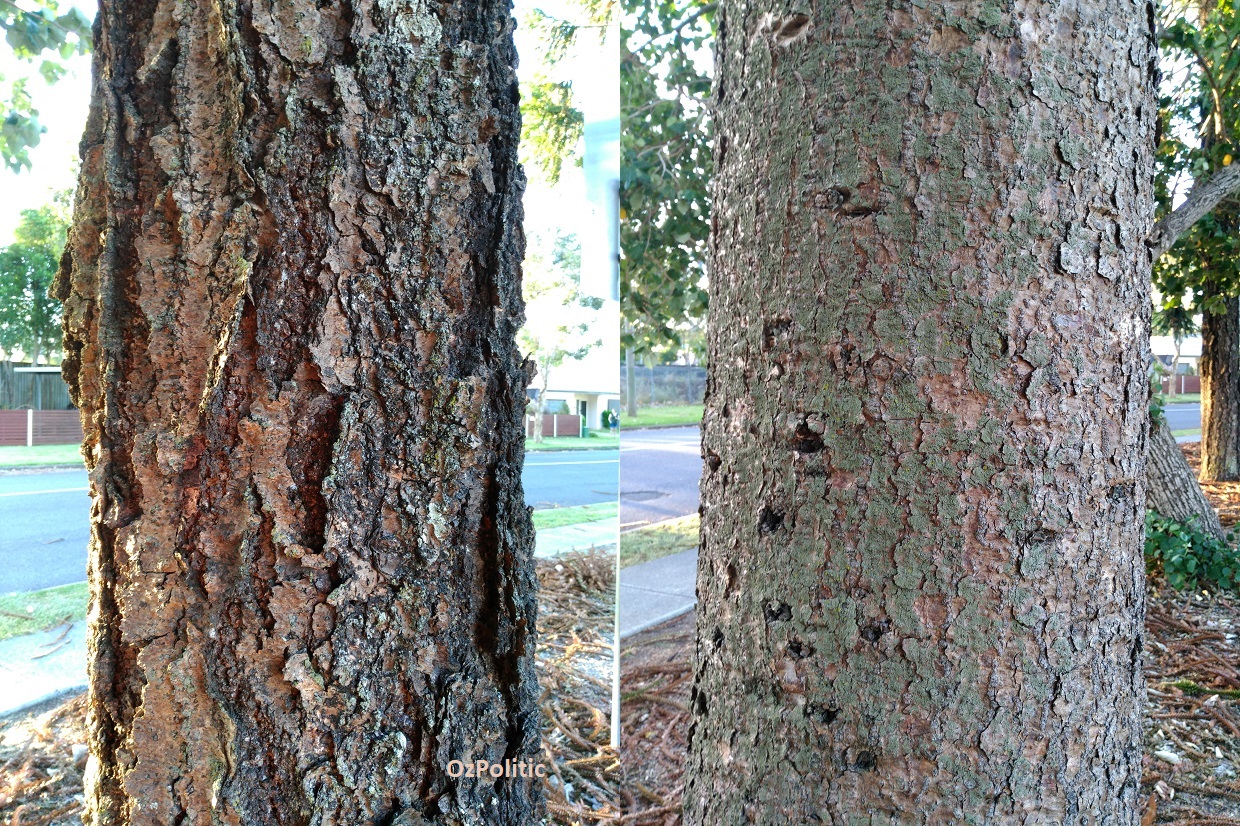
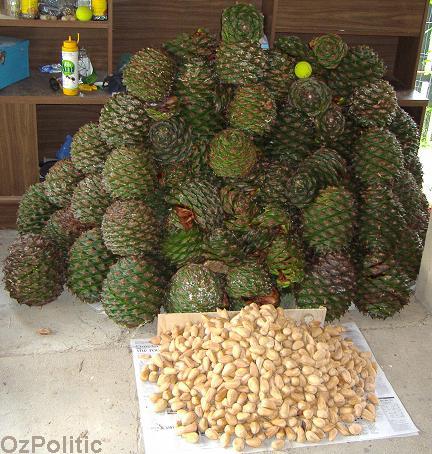

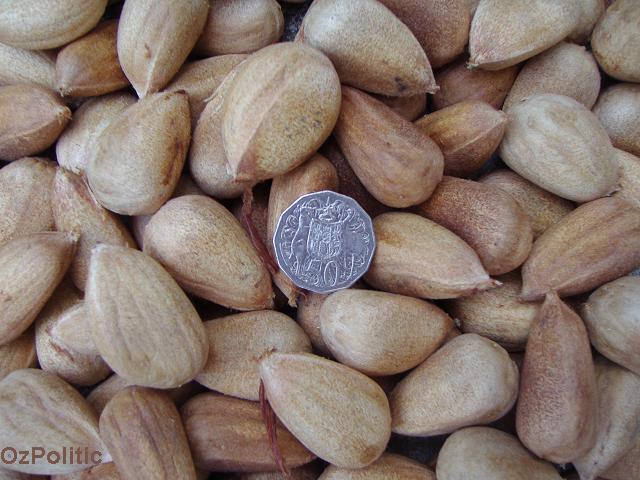
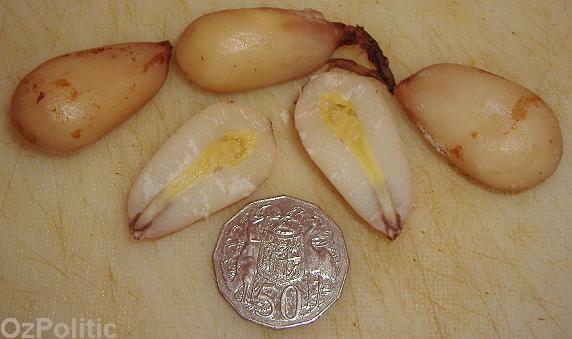
Grape (Vitis vinifera)
top
| Taste | ★★★☆☆ |
| Easy to grow | ★★★★★ |
| Pest resistance | ★★★★★ |
Native habitat: Probably South-West Asia, but other species are native to America. This was one of the earliest plants to be cultivated.
Bears fruit in January.
Grapes are very easy to grow, with the exception that they are usually grown from cuttings rather than seed, and need some kind of trellis, and should also be pruned heavily in winter. I have not encountered any pests, with the exception that crows will occasionally pick ripe fruit. I am not sure why, as I do not think they eat it, and they seem fairly lazy about it, only targeting the grapes that they can reach by walking up to. I often shoo the crows away in the early morning, which is enough to prevent significant losses. I planted two purchased seedlings - Black Muscat and Waltham Cross. With regular watering, they both produced fruit just over 12 months after planting, with the Black Muscat producing a large vine and more fruit than I could keep up with. The Waltham Cross bears fruit a bit later, perhaps February. The Black Muscats have seeds, and the bunch does not ripen all at once, so I pick them one fruit at a time and eat them on the spot. Grapes should be given an occasional deep watering, but not too much mulch or fertiliser, as this encourages growth of leaves at the expense of fruit. Commercial farms tend to be on fairly barren hillsides with shallow, porous soil. Grapes are an ideal vine to grow overhead in a location where you want winter sun and summer shade. Because they can (and should) be pruned very heavily, they do not accumulate the same mass of dead wood as other vines. They also produce a lot of fruit for the plant size. This summer started very dry, but we got heave rain from late December. The grape vine sprouted very late, grew very large, but produced very little fruit prior to the cool weather hitting.
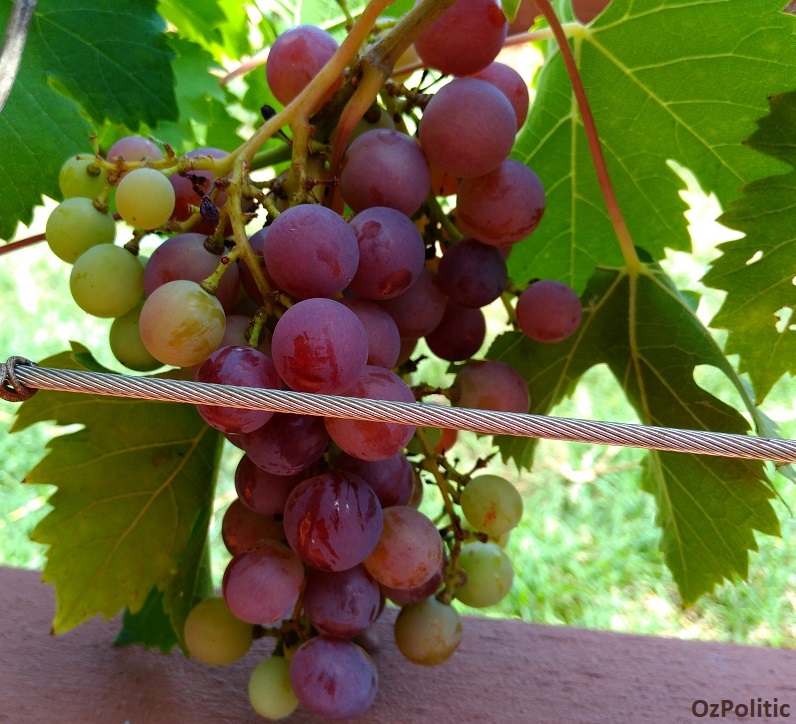
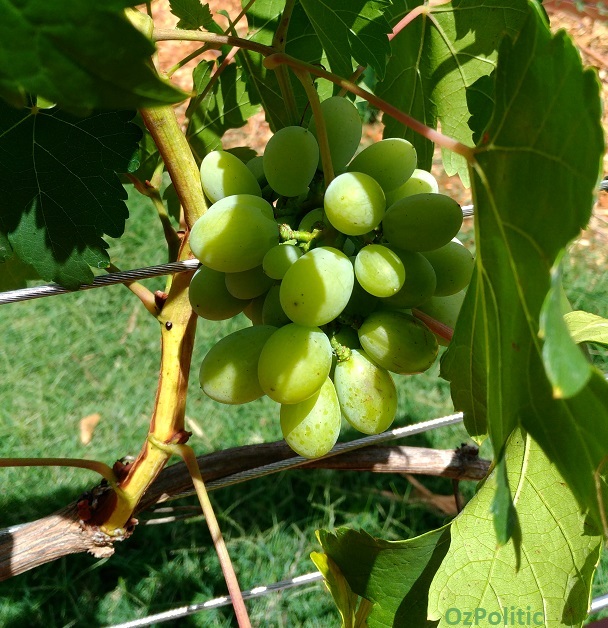
Other fruit I am trying to grow
top
Inga Bean - I cannot seem to get these to set ‘fruit’. They need a lot of water.
Coffee - have had a crop, but never got round to roasting it
Peach - tropic beauty - extremely fast grower, but the crop was destroyed by fruit fly
Green Star Apple - seems to be doing well, and have seen them produce fruit nearby
Purple Star Apple
Avocada - generally does not produce fruit if grown from seed, also has complicated polination requirements
Blueberry - repeated failures
Soursop
Jackfruit
Champadek
Lychee
Longan
Achacha
Cherry of Rio Grande
Abiu
Malabar Chestnut
Midgen Berry
Naranjilla
Yellow Sapote
White Sapote
Pitomba
Phalsa
Cranberry Hibiscus
Roselle
Loquat
Mundu
Pepino
Moringa
Cassava
Lemon
Imperial Mandarin
Kaffir Lime
Tomarillo
Tomatillo
